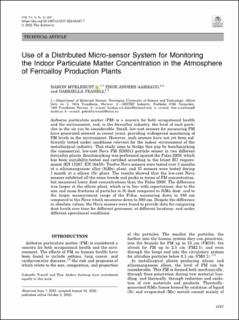| dc.description.abstract | Airborne particulate matter (PM) is a concern for both occupational health and the environment, and, in the ferroalloy industry, the level of such particles in the air can be considerable. Small, low-cost sensors for measuring PM have generated interest in recent years, providing widespread monitoring of PM levels in the environment. However, such sensors have not yet been sufficiently tested under conditions relevant for the indoor environment of the metallurgical industry. This study aims to bridge this gap by benchmarking the commercial, low-cost Nova PM SDS011 particle sensor in two different ferroalloy plants. Benchmarking was performed against the Fidas 200S, which has been suitability-tested and certified according to the latest EU requirements (EN 15267, EN 16450). Twelve Nova sensors were tested over 3 months at a silicomanganese alloy (SiMn) plant, and 35 sensors were tested during 1 month at a silicon (Si) plant. The results showed that the low-cost Nova sensors exhibited all the same trends and peaks in terms of PM concentration, but measured lower dust concentrations than the Fidas 200S. The difference was larger at the silicon plant, which is in line with expectations, due to the size and mass fractions of particles in Si dust compared to SiMn dust, and to the larger measurement range of the Fidas, measuring down to 180 nm compared to the Nova which measures down to 300 nm. Despite the difference in absolute values, the Nova sensors were found to provide data for comparing dust levels over time for different processes, at different locations, and under different operational conditions. | en_US |

